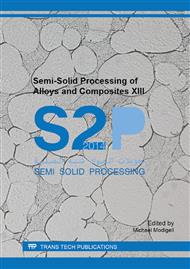[1]
Haga T., Kapranos P., Simple rheocasting processes, J. Mater. Proc. Tech. Vol. 130 – 131 (2002) 594-598.
DOI: 10.1016/s0924-0136(02)00819-1
Google Scholar
[2]
Nafisi S. And Ghomashchi R.,. Grain refining of conventional and semi-solid A356 Al–Si, Materials Characterization 57 (2006) 371-377.
DOI: 10.1016/j.matchar.2006.03.016
Google Scholar
[3]
Seo P.K., Kim D.U. and Kang C.G., The characteristics of grain size controlled microstructure and mechanical properties of Al-Si alloy by thixocasting and rheocasting process, J. Mater. Proc. Tech. 162 – 163 (2005) 570-578.
DOI: 10.1016/j.jmatprotec.2005.02.197
Google Scholar
[4]
Falak P. and Niroumand B., Rheocasting of an Al–Si alloy, Scripta Materialia 53 (2005) 53-60.
DOI: 10.1016/j.scriptamat.2005.03.017
Google Scholar
[5]
M. Rosso, I. Peter, and R. Villa, Effects of T5 and T6 heat treatments applied to Rheocast A356 parts for automotive applications, J. Solid State Phenomena 141-143 (2008) 237-242.
DOI: 10.4028/www.scientific.net/ssp.141-143.237
Google Scholar
[6]
Spencer D.B., Mehrabian R., and Flemings M.C. Rheological behavior of Sn15 Pct Pb in the crystallization range. J. of Metal Trans. 31 (1972) 925-(1932).
DOI: 10.1007/bf02642580
Google Scholar
[7]
Fraipont C., Leocomte-Beckers J. Influence of alloying elements on the thixoformability of a Chromium steel, Trans Tech Publications LTD, Zurich- The 10th International Conference on Semi-Solid Processing of Alloys and Components (2008) 523−527.
Google Scholar
[8]
S. Chayong, H.V. Atkinson, and P. Kapranos. Multi-step induction heating regimes for thixoforming 7075 aluminium alloy, Mater. Sci. Technol. 20 (2004) 490-497.
DOI: 10.1179/026708304225012341
Google Scholar
[9]
Hirt G., Shimahara H., Seidl I., Küthe F., Abel D., Schönbohm A. Semi-solid forging of 100Cr6 and X210CrW12 Steel, CIRP Annals – Manufacturing Technology 64 1 (2005) 257-260.
DOI: 10.1016/s0007-8506(07)60097-3
Google Scholar
[10]
Rassili A., Atkinson H., Thixoforming steel, COST, Shaker Verlag, Chap. 3 37-65.
Google Scholar
[11]
Rassili A., Pierret J.C., Vaneetveld J.C., and Lecomte-Beckers J. Stability of steel thixoforming process, Trans. Nonferrous Mat. Soc. China 2010; 20: 937-942.
DOI: 10.1016/s1003-6326(10)60610-3
Google Scholar
[12]
G. Geymonat, P. Suquet, Functional spaces for Norton-Hoff materials, Mathematical Methods in the Applied Sciences vol. 8 no. 2, 1986 p.206–222.
DOI: 10.1002/mma.1670080113
Google Scholar
[13]
Chenot, J.L., Bellet, M., The viscoplastic approach for the finite-element modeling of metal-forming processes, in: Hartley, P., Pillinger, I., Sturgess, C., (Eds. ), Numerical modeling of material deformation processes: research, development and applications. Springer-Verlag, London (1992).
DOI: 10.1007/978-1-4471-1745-2_8
Google Scholar
[14]
A. Nayar, The Steel Handbook, McGraw-Hill Companies, 1st edition, 2001, Cap. 6, pp.376-377.
Google Scholar
[15]
H. Atkinson, A. Rassili, Thixoforming Steel, COST, Shaker Verlag, Cap. 3, pp.37-65.
Google Scholar
[16]
M. Rosso, I. Peter, FEM analysis for tangible component production, Key Engineering Materials Vols. 611-612 (2014) pp.1657-1664.
DOI: 10.4028/www.scientific.net/kem.611-612.1657
Google Scholar


